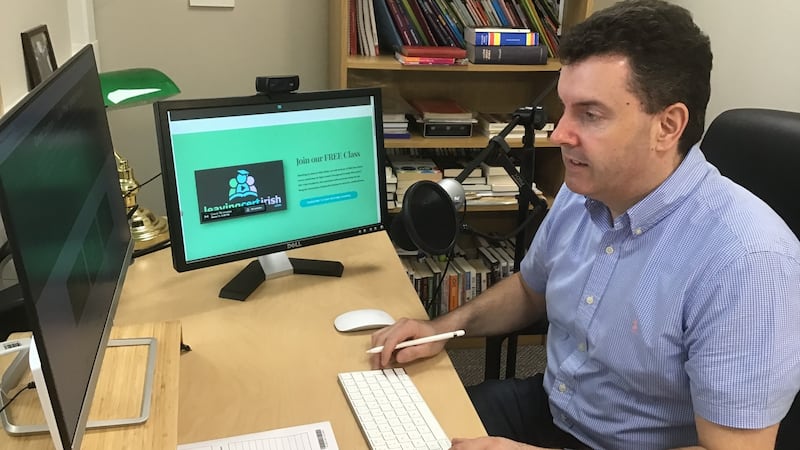‘Start really small’
Sarah-Jayne Carey, ICT, and Leaving Cert computer science teacher at Coláiste Bríde Presentation Secondary School :
Start small and use the method of remote learning that you are most comfortable with.
It all depends on your students, your school set-up, your home set-up. You could send work by email, record short video or audio clips with instructions and explanations, or you could direct your students to the many excellent online resources already available, e.g. Scoilnet.ie. Whatever you do, start small, but do start.
If you are doing a live class or recording a session, there are some tips to consider:
Record a small clip of yourself first. This will allow you to test what the sound is like and also allow you to get used to the sound of your own voice.
Decide what you are going to say to the students in advance - not a script as such, but have a definite direction. It will feel a bit like being a radio DJ with you talking and no feedback, just silence. But don’t be afraid of that, the students are letting your words sink in and formulating questions.
Get all students to turn off their mics and cameras. If they can all see chat to each other it will distract them, especially if this is their first time learning in this way.
Turn off your own camera too if you feel more comfortable. If you don’t know how to, a piece of paper or blue-tac placed over the camera does the trick.
Keep the teaching part short in the beginning, with just a welcome and then instructions on what will be done that day.
Share your notes using whatever screen sharing technology you have, or direct them to where the resources are in their shared space. Then, get them to do a task offline and come back to you.
They probably won’t like sitting and listening to you talking for an hour. Normal classrooms are engaging interactive places with lots going on: group work, individual learning, as well as teaching. The virtual classroom should, in so far as possible, try to be the same.
Top tip: "We are all learning, it will take time and some things will work and some things won't. Go easy on yourself. You will get there, and whichever method you use, the students will be grateful that you are still there, supporting and helping them through this.

‘We have ground rules... when they log in they are in school’
Michael Hallissy is a former primary teacher involved in a digital learning project enabling students in remote Gaeltacht areas to access Leaving Cert subject tuition online:
We’ve been project managing this with the Department of Education and its Gaeltacht policy, which launched on the 1st April 2019.
We have two physics teachers, one is in Dingle and the other in Galway. They teach in their own schools, face-to- face, but they have time from the department to prepare and teach online.
We have eight students in total. They learn online using Zoom and a mix of other platforms like OneNote and Teams. For the students, some of their classes are live while at other times they are working on their own and the teachers are checking on them.
It has been hugely successful. We have students who would not be able to study physics if this project was not in place. It is a blended program and there is some face-to-face but there is very little - maybe twice a year. The rest of it is online, which is either live or asynchronous, which means they work on their own and submit their homework.
Top tip: We have ground rules which the students must follow . They may be at home but when they log in and use their e-hub email they are in school.

‘The website Scoilnet has been an absolute Godsend for me’
Damien Lonergan, Secondary French, German and ICT teacher in Comeragh College, Carrick-on-Suir, Co Tipperary
For online instruction we have to make sure that we create meaningful learning experiences. At the end of the day pedagogy has to be there and online instruction enhances that.
I’m using the eTwinning platform. It connects different schools around Europe, so from a languages perspective it is great because I can continue with a lot of my instruction with them.
The PDST also has a lot of content dedicated to distance learning and I'll be using a lot of that.
The website Scoilnet has been an absolute Godsend for me. You can browse for resources that will help you for your instruction and upload your own too.
We also use Microsoft Teams. I can communicate with my class via a message or a team call. As a language teacher, I want to make sure that I am encouraging speaking as much as possible,so we have Team calls scheduled. This means their language and spoken interaction isn’t hindered because of the closures.
Top tip: You have to be realistic when setting tasks. The students aren't in class, so the assignments are going to take longer. You have to be explicit in your instruction and specify the length of time that they should be spending on tasks that you create.

‘The online silence will seem very new and strange at first’
Dr Yvonne Crotty, Associate professor in DCU’s school of Stem education, innovation and global studies and a former secondary school teacher.
If you can use a smartphone and book a service online, then there is no need to worry whether you can teach online.
“You can. You already have your teaching skills and your subject knowledge. You already have a relationship with your students and classes. Now it is just a question of bringing that familiar classroom dynamic to a new way of teaching or lecturing.
Many educators have been creating fantastic online resources for years and it is wonderful to see these being shared now among parents, teachers and students. A great sense of collaboration exists. Twitter is alight.
But these valuable technological resources are only part of the story. Teachers already know how to teach and understand how their students think and learn. What they need to ask themselves now is how best to transfer these skills online in an engaging way. How do they deal, for example, with the challenge of teaching without eye contact and body language?
My practical advice is that educators need to look at the pedagogical design of their lessons. Varying tasks for students is important. Encouraging collaboration between students through online tools such as Google or Microsoft apps enables them to work together in real time.
Asking them closed questions at the beginning of an online session in a chatbox can encourage more participation. If your online system, for example Zoom or Adobe Connect, allows the use of breakout rooms for students to discuss topics, this feature also can be a very effective teaching methodology to encourage interaction.
Top tip: Teachers should remember to be natural and bring humour and creativity to lessons, just as they would in any classroom setting. The online silence will seem very new and strange at first after the usual shuffling and noise of a classroom. Don't be afraid of it because we are all in this together!
‘Keep lines of communication open with parents’
Ailbhe Forde, Second class primary school teacher:
Due to the hands-on and practical nature of teaching and learning at primary level, finding and using an effective means for remote learning and communication will be challenging as online tools may not have been established and tested.
If possible, use systems that are already in place in the school that teachers, parents and students are familiar with, for example Microsoft Teams, Aladdin Connect, the school website and the school/class Twitter page.
“Support is vital in these uncertain times. Keep up collegial support and use outlets such as the Irish educational community on Twitter (#edchatie and #edshareie) for advice and ideas on teaching and learning during this unknown time.
Fantastic resources such as lists of websites and applications suitable for various class levels and subjects have been compiled and shared by teachers and schools for use at home in the coming weeks.
Fortunately, we were able to set work for our students in a short space of time when schools closed initially by sending home suggested work for the coming weeks to maintain structure to their education.
Students have also been set-up with online users for reading free ebooks, with a facility for teachers to set reading and assignments using the application.
Top tip: Keep lines of communication open with parents/guardians via email and our school application (Aladdin Connect). Using this application, I can set daily work for my students with resources to assist them. Our school website and Twitter page will be updated with information regarding work for students and suggested online/offline resources.

'Take it step-by-step. Don’t bite off more than you can chew’
[ LeavingCertIrish.comOpens in new window ]
In our school, we use Office 365, Microsoft Teams and Edmodo, a learning management system.
I send recorded lessons or webinars to my students. I’m essentially screencasting from my computer. Jing is basic free version for doing this, while Camtasia is a more advanced screen recorder and video editor.
The class is normally no more than 10 to 15 minutes, because you’re building in time for students to apply what they’ve learned. It allows students to control the pace of their learning and understanding, to pause and take notes.
I also use Quizlet, a free app, to reinforce the learning of language and vocabulary. It divides the class up into teams where they can compete against each other.
We normally do it in class and it’s great craic; they’re knocking down chairs and tables to compete. It’s very engaging.
Live-streaming a class is very demanding: you don’t want to bite off more than you can chew unless you’re very experienced in remote teaching.
Top tip: "You're better off recording a master lesson. Or even try a low tech solution like an audio file, explaining a section in the textbook,and let students send in emails or set up a class conversation on Microsoft Teams."

‘Don’t reinvent the wheel, look for resources already out there’
Conor Power, History, CSPE and computer science teacher at Coláiste Chiaráin, Croom. Co. Limerick:
At my school we are long-time users of G Suite and Google Classroom. All our students are experienced users and our teachers were already using it extensively to support teaching and learning. It has now moved from being a powerful way to enhance learning to being absolutely central to the continuity of learning.
Students are very comfortable with using technology to learn just about anything so schoolwork should be no different. From a teacher’s point of view, rather than explaining the topic repeatedly, you can produce it in video which can then be revisited.
I feel the technical hurdles are not what they once were. Software is easier to use and the rise of cloud-based platforms has done away with the need for hardware and software configuration. Cross platform support means ‘learn anywhere’ is possible as popular platforms support phones, tablets and low-cost laptops.
Top tip: My advice for teachers is to be realistic in setting work. If possible, schedule work so it is assigned in line with your normal timetabled hours. Don't reinvent the wheel, look for resources already out there that you can customise or curate for your students.

‘Use web versions of tools to cut down on technical problems’
Dr Declan Cathcart, Maths and biology teacher at Temple Carrig secondary school in Greystones, Co Wicklow:
We have been using Schoology for six years, so we can set and grade assignments online, as well as communicate with students via its messaging tool.
Technical issues do arise from time to time, but all of our students have iPads which are set up by the school’s IT staff, so we know what works and what doesn’t.
I often find that if students use web versions of the tools that we use, there are fewer issues of compatibility or things not working on older devices.
For maths, I’m continuing to use Khan Academy to set assignments, and will be doing live video lessons of me showing students solutions to past exam questions. I use a document camera to do this. I also record videos so that students can review them whenever they want.
I’m now also doing live lessons using the Conferences app built into Schoology, which is a basically a webinar tool. It allows me to do live lessons and screen share with my senior biology students, so that I can run through a Powerpoint presentation or a worksheet which they can see on their screen and hear me explain.
Top tip: Khan Academy allows the teacher to set and sequence maths exercises and track students' progress so you can intervene when you see on your dashboard that a student is struggling. It also allows gifted students to work ahead at their own pace.

‘The Seesaw app empowers pupils to create, reflect, collaborate and share’
Valerie King , Primary school autism spectrum disorder (ASD) class teacher:
“I think there may be some benefits to remote learning for primary school children but more so with older students. Younger ones may not be able to sit for a virtual lesson with distractions at home.
The boys in my class range from the ages of five to seven years old, and I know a virtual classroom would not work for us and will instead be using online tools. I highly recommend the Seesaw App, a student-driven digital portfolio which empowers students of any age to create, reflect, collaborate and share.
I use it as a means of communicating with the parents in my class and to share photos of what we get up to throughout the day. It is very straightforward and parents are very familiar with it.
SeeSaw can also be used as a means of portfolio learning and assessment for children, where they can upload work samples, and get feedback from their teacher on it.
I hope to continue using this app throughout the next few weeks to keep in contact, to share links and activities, and to answer any questions they may have. If schools close for longer, teachers may need to re-evaluate and look towards other options such as Google classrooms.
I also have a number of free resources on my website - www.muinteoirvalerie.com - to assist with learning at home."
Top tip: For parents with students who have additional learning needs, I would simply encourage them to try keeping their children calm and happy during this disruptive time. Try having a routine and structure in place for your child, work on activities similar in nature to what they are doing in school, and in consultation with their teacher where possible.
Do you want to share your teaching experiences? Email Irish Times education editor Carl O’Brien: cobrien@irishtimes.com












